Address any questions or comments regarding this newsletter to the individual authors listed after each article or to its editors, Nathan Johanning, 618-939-3434, njohann@illinois.edu or Bronwyn Aly 618-695-6060, baly@illinois.edu. The Illinois Fruit and Vegetable News is available on the web at: http://ipm.illinois.edu/ifvn/. To receive or be removed from email notification of new postings of this newsletter, contact Nathan Johanning or Bronwyn Aly at the phone numbers or email addresses above.
In This Issue:
Upcoming programs (listings for beginning and established growers)
News & Announcements (2021 Summer Hort Field Day)
Regional Reports (SoSuCo (Matteson), St. Louis metro east, southwestern Illinois (Waterloo), southern Illinois (Murphysboro), Dixon Springs)
Fruit & Vegetable Production & Pest Management (Growing Sweet Corn At Higher Densities Doesn’t Increase Root Lodging Risk, April Brought a Mix of Winter, Spring, and Summer Weather, 10 Useful Rules for Fungicide Applications, A New Strawberry Disease)
Upcoming programs
See the University of Illinois Extension Local Food Systems and Small Farms Team’s website at:
http://web.extension.illinois.edu/smallfarm/ and the calendar of events at http://web.extension.illinois.edu/units/calendar.cfm?UnitID=629.
- 2021 Summer Horticulture Field Day, Thursday, June 10, 2021, in person at Edwards Apple Orchard West, Winnebago, IL. Save the date and make plans to attend the annual Summer Hort Field Day sponsored by Illinois State Horticulture Sociey, Illinois Specialty Growers Association, and University of Illinois Extension! For more information or to register online visit https://www.specialtygrowers.org/summer-horticulture
- 2021 Southern Illinois Summer Twilight Meeting Series, monthly evening meetings May-August at 6 p.m. After a year off, plans are underway to host IN-PERSON twilight meetings across southern Illinois during the 2021 growing season. For more information visit https://extension.illinois.edu/news-releases/2021-southern-illinois-summer-twilight-series or to register online directly, visit go.illinois.edu/2021TwilightSeries
- June 21, 2021 Dixon Springs Agricultural Center, Simpson, IL – high tunnel insect management & vegetable production
- July 12, 2021 Baebler Educational Farm, Waterloo, IL – no-till tomato & pepper production
- August 16, 2021 Bauman Family Farm, Vienna, IL – regenerative grazing in cattle productio
News & Announcements
ILLINOIS STATE HORTICULTURAL SOCIETY PRESENTS
2021 Summer Horticulture Field Day
Thursday June 10, 2021 at Edwards Apple Orchard West, Winnebago, Illinois
Pre-Registration is $30 per person, or $40 at the door (includes lunch). Children under 12 are welcome free of charge!
Please register before June 1st!
REGISTER & PAY ONLINE AT WWW.TICKETTAILOR.COM/EVENTS/ISHS
2021 HORT DAY FLYER & TENTATIVE AGENDA
Note from ISHS Vice President
Summer Horticulture Day is my favorite of our meetings as a member of the Illinois Specialty Growers Association. I love taking a break from our summer work to visit another growers farm. There is always something to learn from this experience, even if it is something small, like a new trick for planting pumpkins, different signage to use on the farm, or a new way to package and sell produce, and usually some bigger things as well, such as how to manage Phytophthora in apples from Dr. Mohammad Babadoost. Summer Horticulture Day is also a great time to reconnect with old friends and industry supporters. I have made some of my very closest friends through this field day, and always try to meet new people as well.
Sincerely,
Jenna Spychal
Illinois State Horticulture Society (ISHS)
Summer Horticulture Field Day Coordinator
After a year of many challenges and online meetings for our industry, the Illinois State Horticultural Society is proud to announce the return of our in-person Summer Horticulture Field Day at Edwards Apple Orchard West in Winnebago, Illinois.
The Edwards Family is proud to invite guests to tour their orchard and farm market operation on Thursday, June 10th for the annual event. The orchard has been open for over 30 years and features 18 different varieties of apples from over 8500 trees, freshly made apple cider, and their famous apple cider donuts. They also have pick-your-own pumpkins & raspberries, and grow autumn mums for fall displays. Activities include wagon rides, a children’s play area, and petting farm with a goat walk. Their farm market and bakery are located inside a beautifully renovated dairy barn built in 1893 providing the perfect backdrop for their unique seasonal gift items, food products, fresh apples, cider & donuts. Not only will this be a wonderful time to learn about the Edwards Family’s operation and experiences, but guests will also be able to speak with industry vendors, learn about new equipment and products, and speak with other growers from all over the state. There will also be specialty crop experts from the University of Illinois & Extension available on our field tour to discuss specialty crops, disease & pest management, and more on apples, pumpkins, raspberries, and mums.
Join us for field & orchard tours with Ag Specialists from the U of I and Extension discussing current management practices of apples, pumpkins, and raspberries. We will also discuss high-density orchard management, using drones on your farm, transitioning to the next generation, and more. Lunch will feature networking opportunities with growers and relevant industry businesses, as well as discussions on-farm marketing.
Farm & Field Tours
- Pruning & Training High-Density Apples
- Troubleshooting your Bakery & Farm Market during busy season
- Using drones for Marketing
- In Field Discussions with University & Extension Specialists on Apples, Pumpkins, Raspberries, & Mums
- Plus more!
Directions: Edwards Apple Orchard West is located about 9 miles Northwest of Rockford off Meridian Rd, on Cemetary. Address: 8218 Cemetary Road Winnebago, Illinois 61088
Lodging Options: Riverview Inn & Suites - 700 W. Riverside Blvd., Rockford, IL (815) 282-3033 Located about 9.0mi or 14min from Orchard Embassy Suites -416 South Main Street., Rockford, IL (815) 668-7878 Located about 10.2 mi or 17 min from Orchard
For details & general information on the program or the event, contact: Jenna Spychal - ISHS Field Day Coordinator (217) 254-5258, jenna@jonamacorchard.com.
Kacie Athey (217-244-9916; kathey@illinois.edu)
Regional Reports
From the South Suburban Cook Urban Agriculture Demonstration and Research site (SoSuCo) in Matteson, IL (Cook County)…General Site Updates: We are getting closer to finishing the installation of our multiple irrigation systems at SoSuCo. In the below image, you can see that we are embedding some redundancy in our system by having both drip and overhead irrigation in some circumstances. If this spring indicates the precipitation we will receive this season; then we will need to rely heavily on our ability to irrigate our production areas. I am a heavy user of the various services that NOAA provides. Tracking overall precipitation is helpful in irrigation management. A quick look at the Advanced Hydrologic Prediction Service will reveal the heavy variability in precipitation throughout Illinois this spring. Here in the greater Chicagoland area, some areas are currently in a moderate drought. As I write, the above-linked AHPS site is currently down, so I encourage you to explore the differences between precipitation between this spring and last!
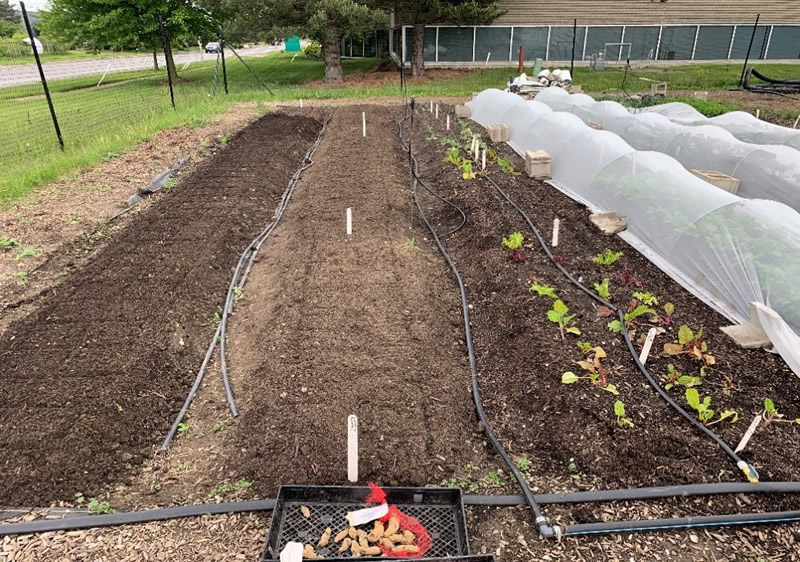
Installation of both drip and overhead irrigation systems at the SoSuCo demonstration site. Photo by Z. Grant.
We had an important reminder of why it is crucial to have pre-emptive conversations with your neighbors and site partners about vapor drift from herbicide application in the high tunnels. The tomatoes in our tunnels were subjected to 2,4-D vapor drift that was sucked into our end wall louvers via negative pressure. The applicator sprayed about 20 feet east of the end wall in the below left picture. The subsequent two days of sunny 80F+ temps volatilized the 2,4-D moved quickly into the tunnel. The tomatoes are recovering, but this is an important lesson to have conversations with applicators and put up signage to indicate no-spray areas.
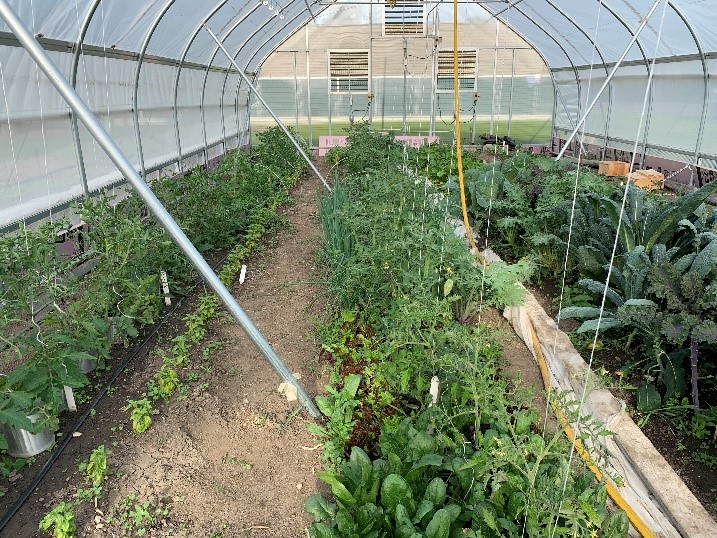
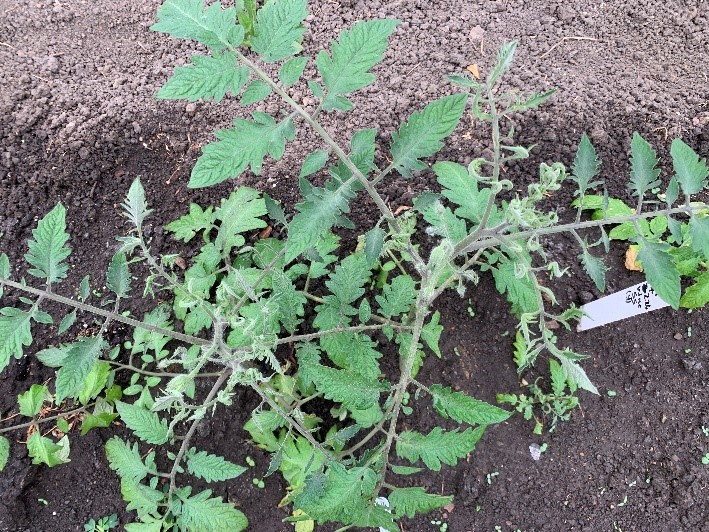
Left: High tunnel at the SoSuCo demonstration site. Right: Tomato damaged by 2,4-D vapor drift in high tunnel at SoSuCo demonstration site. Photos by Z. Grant.
Finally, we are beginning to monitor for Swede Midge at our site in Cook County with a couple of other growers. Swede Midge damage has been detected in Brassica crops in Cook over the past few seasons. Our monitoring project attempts to detect Swede Midge's emergence in late May and perhaps apply some control measures before larvae are deposited in the growing meristems of susceptible Brassica hosts. As you can see below, we have modified a delta trap with a pheromone lure and suspended it perpendicular to the soil to capture emerging adults. Here is a video from my Urban Ag Connect Vlog series describing the process. I would encourage you to follow my series on our YouTube channel for more on-farm learning.
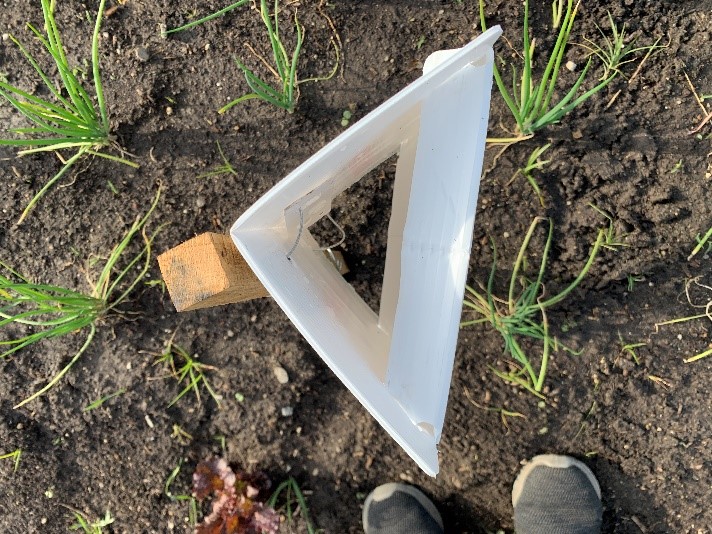
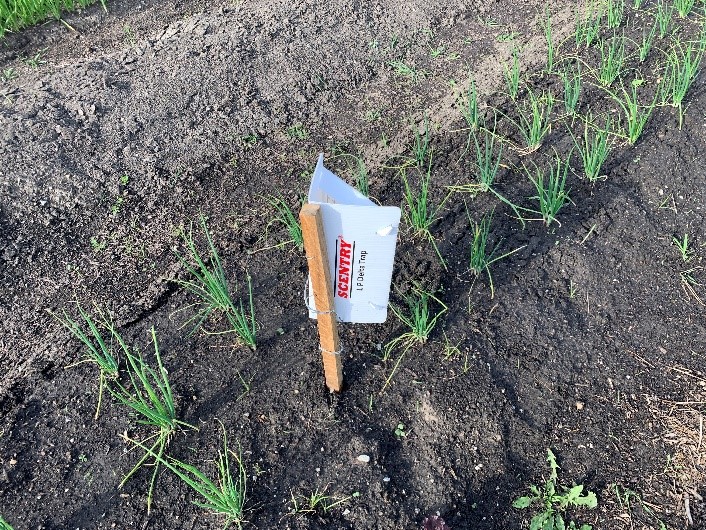
Traps used to monitor for Swede Midge emergence at the Cook County site. Photos by Z. Grant.
Zachary Grant (708-449-4320; zgrant2@illinois.edu)
St. Louis metro east…Much of the region has been receiving rain, at a time when it was needed and just ahead of weekend u-pick business for strawberries, asparagus and early vegetables. Soil temperatures have risen to the low 60s and should continue to climb with the much warmer temperatures predicted in the forecast. The peach crop looks good, with fruit thinning just getting started. On that note, if all goes as planned, Valent hopes to receive approval from the EPA sometime this fall for a new chemical peach thinner under the trade name Accede with the active ingredient 1-aminocyclopropane carboxylic acid (ACC). I’ll keep you posted as details are released.
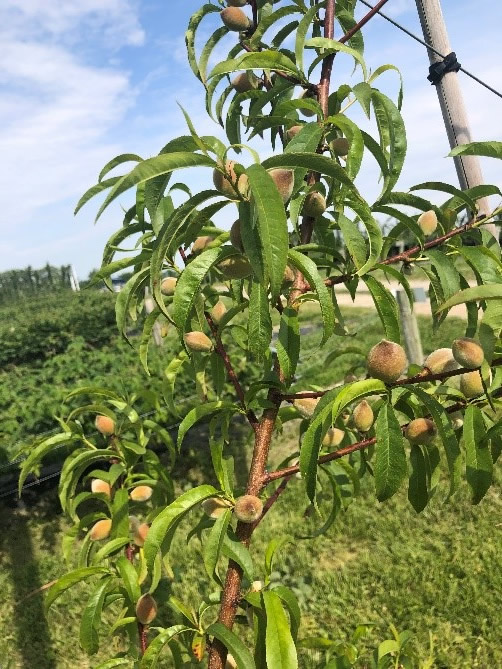
The apple crop is sufficient, with some reporting certain varieties being light due to late spring freezes and poor pollinating conditions. Conditions for thinning those cultivars that set well have been suboptimal as well, and efforts continue to set the final crop.
Grapes suffered some primary bud damage from late spring freezes, resulting in secondary and tertiary growth. Many cultivars are less productive on secondary growth, and growers are needing to readjust canopies to remove excess shoots. Blueberries came though the spring frost and are sizing. Blackberries are in various bloom stages to early fruit set.
Sweet corn plantings are ongoing. Those in the ground have taken a visible jump with the recent rain. Next up will be cantaloupe and pumpkins.
Reminder - We are looking for Apple and Peach growers who have maintained bloom records for the past 25 years or longer and would be willing to share that data with the Illinois State Climatologist Trent Ford. He is interested in taking bloom data to see how it correlates to changes in our overall climate. Contact Elizabeth Wahle at wahle@illinois.edu or 618-217-300-9541 if you would be willing to participate.
Elizabeth Wahle (618-344-4230; wahle@illinois.edu)
From southwestern Illinois (Waterloo)… We have finally gotten into some more “summer-like” weather after having very cool temperature the first part of May. Early May had many nights with lows at or near 40° and highs in the 50s and 60s. In the last week we have finally warmed up and most recently been in the mid 80s. We have had some rainfall (about 0.9”) in the last week or so but things are reasonable dry and many young crops would appreciate some rainfall. That rain is predicted to come towards the end of this week, also with a cool down back to highs between 70-80°.
The weather has been good for some crops, however, many also have struggled. The sustained cool has been great for lettuce, cole crops, and asparagus which do not appreciate the heat we usually have by May. On the other hand all of our summer annual vegetables like tomatoes, peppers, cucurbits, beans, and sweet corn, to mention a few, have been struggling until the weather has heated up. I have seen many reports of growth issues both in field and in high tunnel most all of which relate back to the cold. Even though we haven’t had a frost, just these crops stuggle to grow as usual with such cool soils and air temperatures. The last week has really perked things up its amazing how much good some warmer temperatures can do!
Out in the field, potatoes are looking very good and have enjoyed the cool weather. Apples are doing fairly well although the fruitload is variable. Just in the last week I have noticed a little bit of fireblight, but so far localized and not widespread. Blueberries are progressing well and I would expect the first few to start to ripen in early June. Tart cherry will be ripe soon, however shortly after I took the picture below “a party” of racoons clean out every single cherry on two mature trees and a few younger ones all in one night. All that remains is a few broken branches. I hope they had a good tummy ache after that! My oat and berseem clover cover crop is very happily continuing to put on more biomass. Soon we will be planting the second year of no-till tomato and pepper trials in Waterloo and Urbana. Stay tuned for more details in the next IFVN!
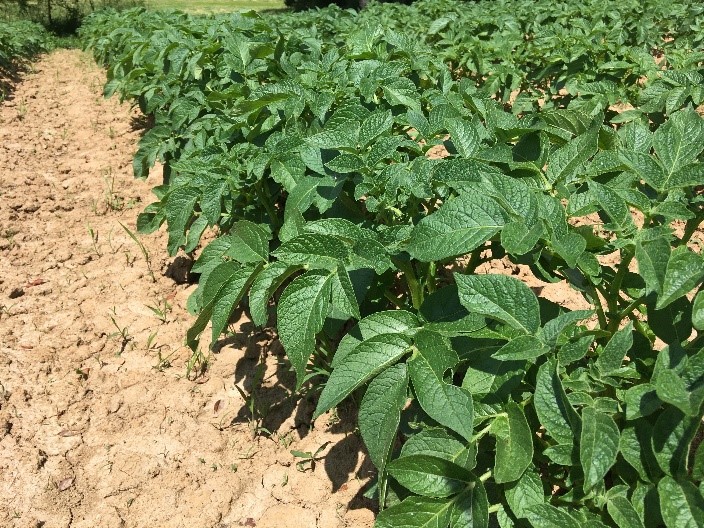

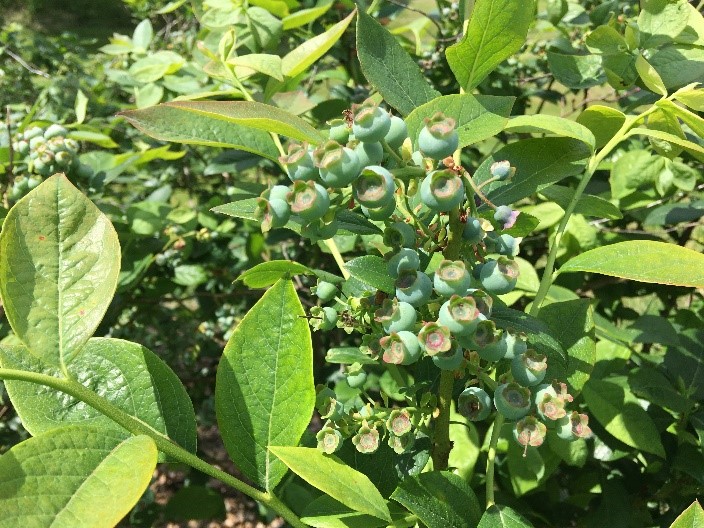
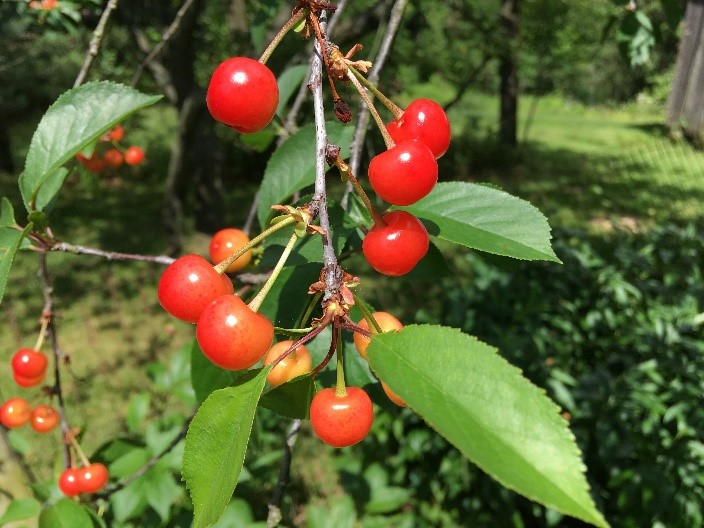
Current field growth of potatoes (top left), fireblight strike on apple (top right), blueberries (middle left), tart cherries (middle right), oat and berseem clover cover crop (bottom). Photos: N. Johanning
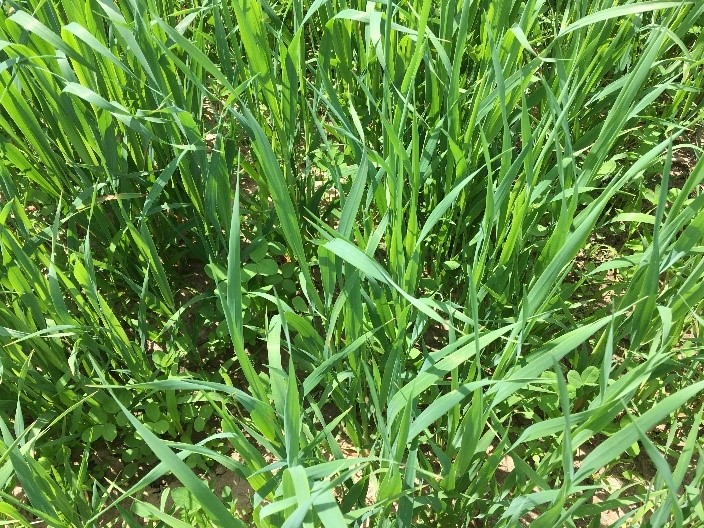
Looking forward to seeing some of you at the State Hort Field Day at Edwards Apple Orchard West!
Nathan Johanning (618-939-3434; njohann@illinois.edu)
From southern Illinois (Murphysboro)… Around the Murphysboro grounds the blueberry bush is setting fruit, the blackberries are flowering, and the yellow squash planted in raised beds are setting fruit. The asparagus harvest is still going strong with 18 harvests so far.
On May 13 we planted the fertigation tomato trial. 250 ‘Red Deuce’ tomatoes were no-till planted at a 2ft spacing, they will be watered and fertigated with drip irrigation. Plants will be pruned to the first flower cluster and tied in the Florida weave system. I want to thank interns Jake Newbury and Anna Kistner, and program coordinator Maggie Ray for help with plot layout and planting.
The high tunnel has been planted with a variety of hot peppers including poblano and jalapeno, sweet onions, and green bell peppers. Some of the heirloom tomatoes planted in April are starting to set fruit. A portion of the green beans from the variety trial were seeded in cell trays to be transplanted into the black plastic. Several types of cut-flowers including snapdragons, straw flowers, and zinnias have been planted in the high tunnel and outside in raised beds.
Activities here at the office and around the unit are really ramping up. I look forward to seeing how this growing season progresses!
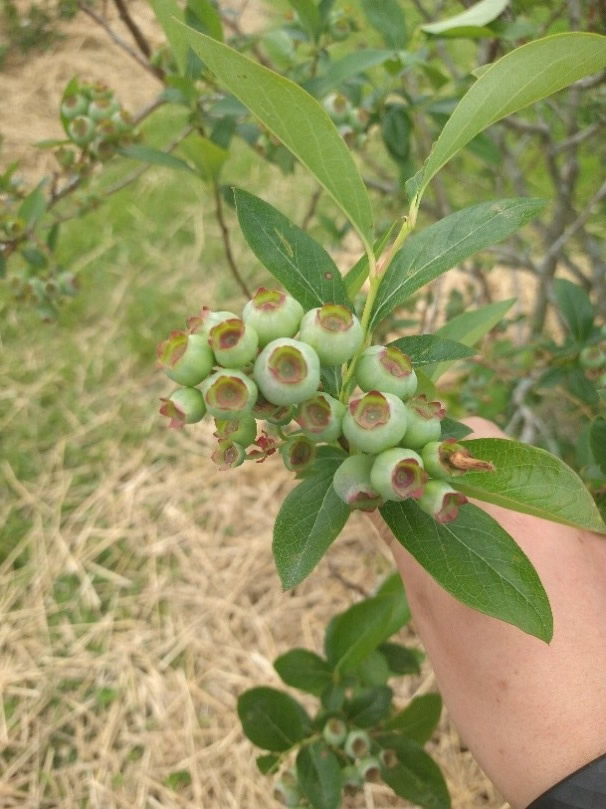
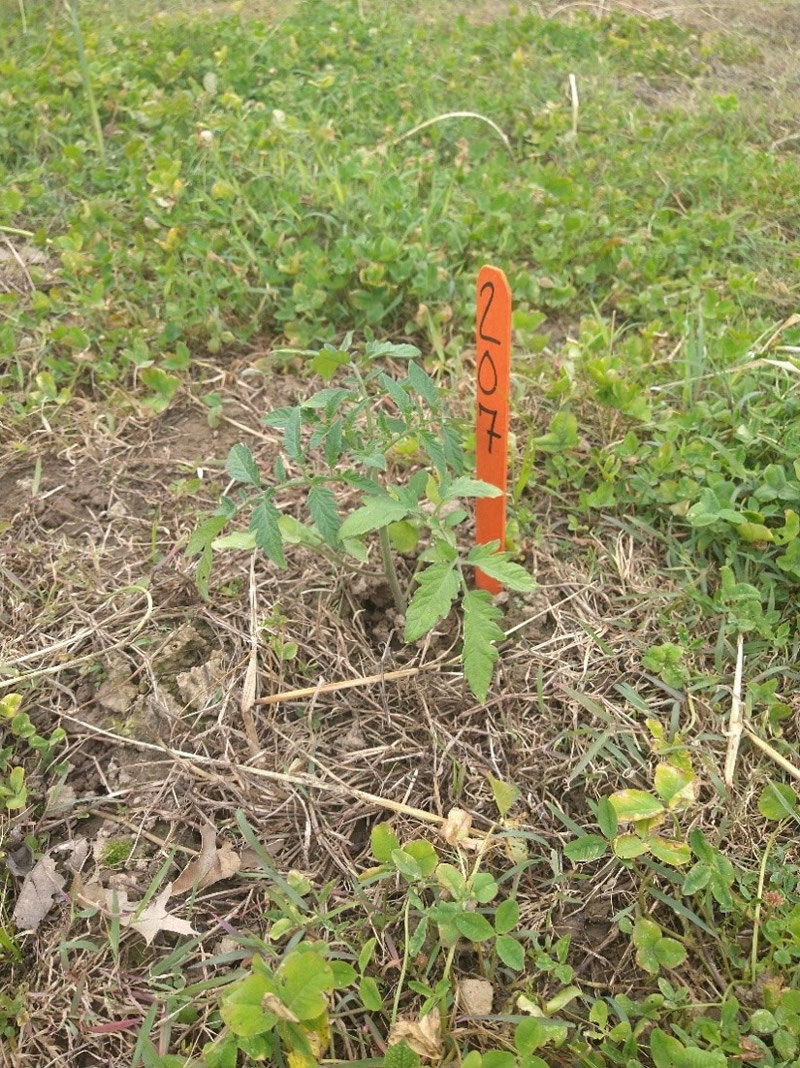
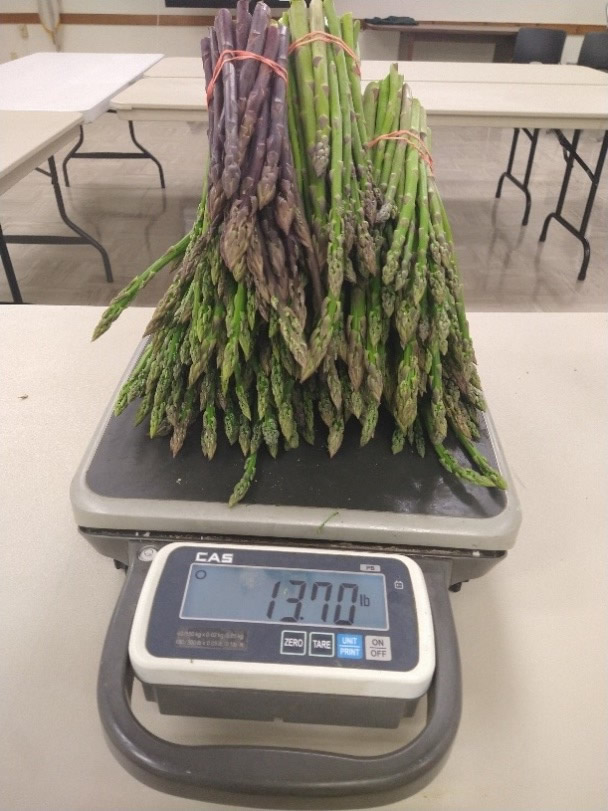
Clockwise starting at top left photo: Green blueberry fruit sizing, tomato transplant in no-till tomato fertility trial, and asparagus harvests still tipping the scales and going strong from plantings in Murphysboro at the Jackson Co Extension office. Photos by K. Bell.
Katie Bell (618-687-1727; klbell@illinois.edu)
From Dixon Springs Ag Center…Warmer, sunny summerlike days are finally upon us and at least for locations around the Dixon Springs Ag Center, an ample and steady amount of moisture continues to be available in the soil. Over the weekend, I was in northern Indiana and northern Illinois and I saw clouds of dust rolling up behind farmers as they were working fields in various capacities and noted how much drier that region of the state was compared to my location in the far southeast.
Harvest has started on the hydroponic raspberries, with ‘Joan J’ ripening about a week ahead of ‘Double Gold’. ‘Niwot’, the black raspberry, was the latest of the three to begin ripening, and while it seems to have more fruit than the other varieties, the fruit is smaller and is extremely crumbly when trying to harvest. Primocanes of both ‘Joan J’ and ‘Niwot’ should have open flowers by next week. Spider mites are very obvious on all of the varieties, with webbing and the bronzy, discolored leaves of reduced vigor.
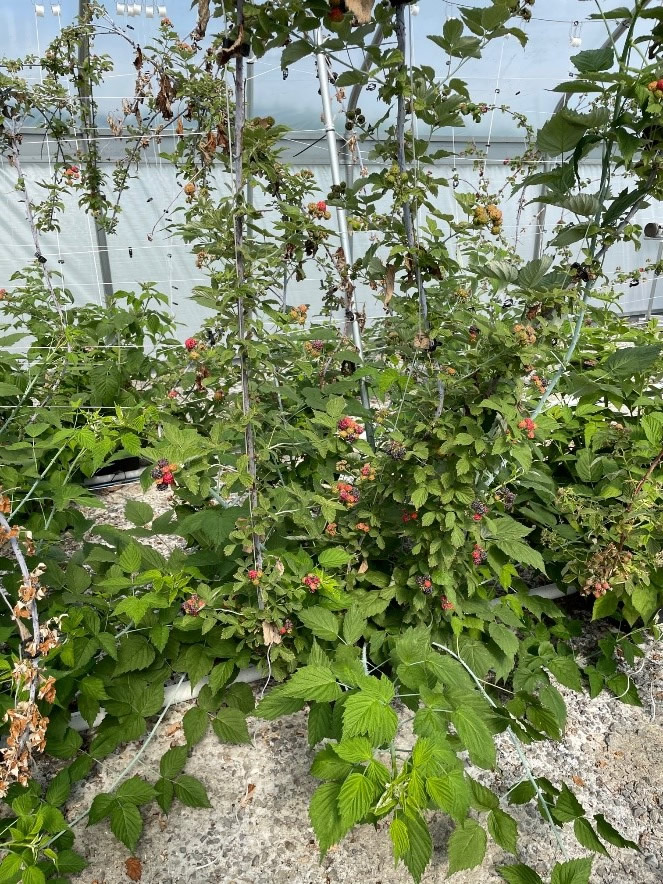
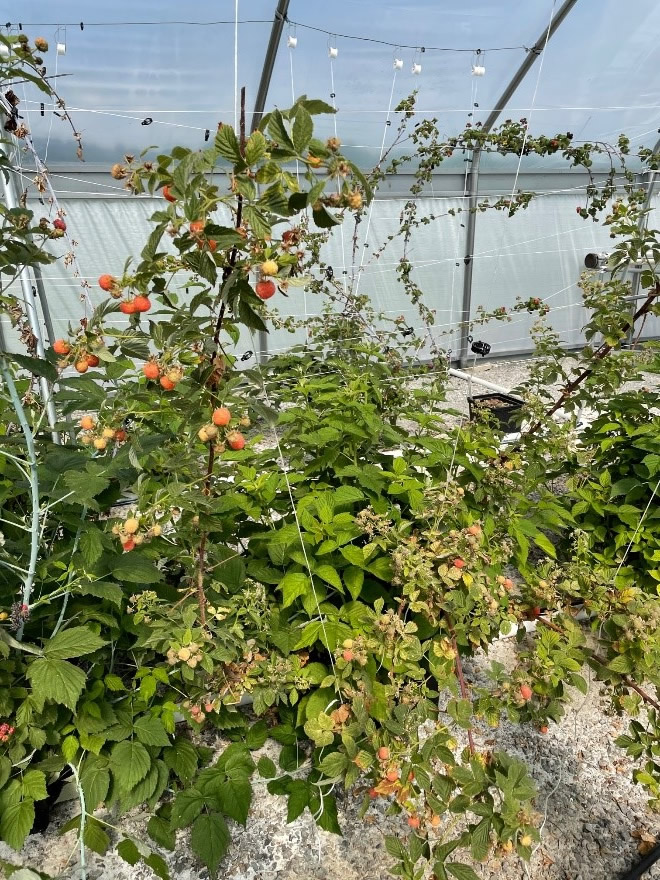
Left: ‘Niwot’ black raspberry fruit starting to ripen on floricanes overwintered in the hydroponic tunnel at DSAC. New primocanes are already 3-4 feet in length and ready to be tied up and tipped. Right: ‘Double Gold’ raspberry fruit are also ripening and new primocanes are growing out as well. Photos by B. Aly.
As in years past, we are seeing populations of the “Big Three” insect pests - aphids, thrips and spider mites – build up in the hydroponic tunnel. These pests, and others, will also eventually be in the other tunnels as well, but for us, they typically start in the hydroponic tunnel. As part of the sustainable insect pest control project that we are working on with Dr. Athey, we released our first round of natural predators in the hydroponic tunnel and one of our other tunnels with in-ground raised beds. The third tunnel will act as our control tunnel and will receive no natural predator releases or chemical control for aphids, thrips or spider mites. Dr. Athey released three different types of natural predators, an orius, a lady beetle, and a mite, and will be back on-site next week to collect data. Please consider attending the June 21, 2021 twilight meeting at DSAC to learn more about this project and high tunnel insect pests https://go.illinois.edu/2021TwilightSeries

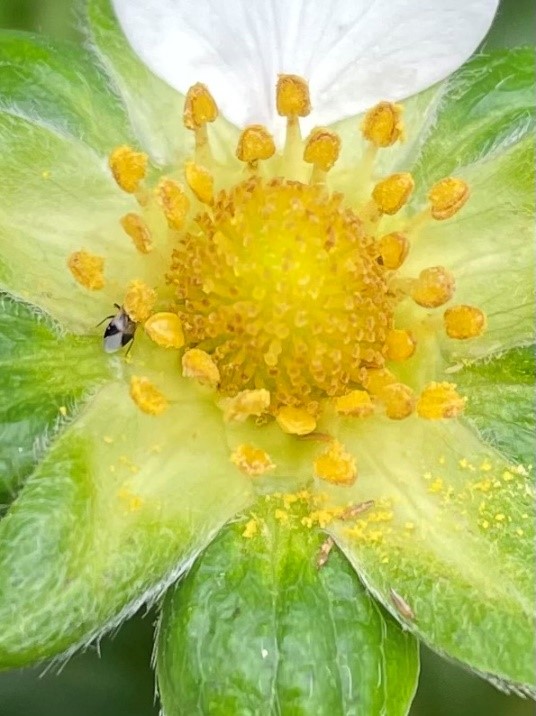
Left: Three different types of natural predator insects were released in high tunnels at DSAC as a biological control strategy to work against insect pests present in the tunnels. Right: Orius hanging out in a strawberry flower with a few thrips one week after being released in the high tunnel. Photos by B. Aly.
Overall, the crops are growing well in all of the tunnels at DSAC. Daily maintenance is needed to keep cucumbers and indeterminate tomatoes suckered and clipped. The other tomato plots are already three strings high in the trellis weave system and the fourth string will be needed by the end of the week. Early planted kohlrabi and celtuse has already been harvested and the areas reseeded with radish and beets. Cucumbers will be ready for their first harvest by May 28 (transplants were put out later than normal this year, as typically our first cucumber harvests are at the very end of April or the first of May). The tomatoes in the potassium fertility trial are growing and sizing fruit nicely. Some of the indeterminate cherry tomato varieties (‘Sun Sugar’, ‘Honeycomb’, and ‘Chocolate Sprinkles’) have ripe fruit on the first clusters.
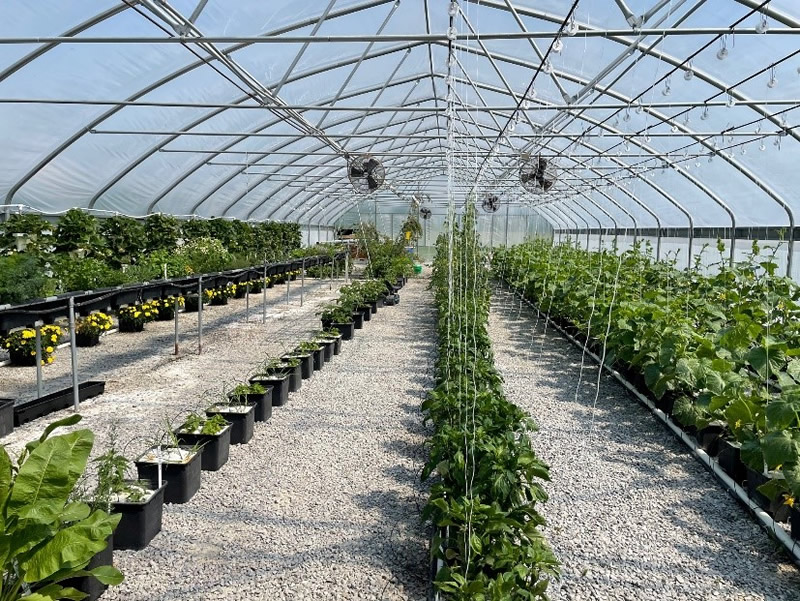
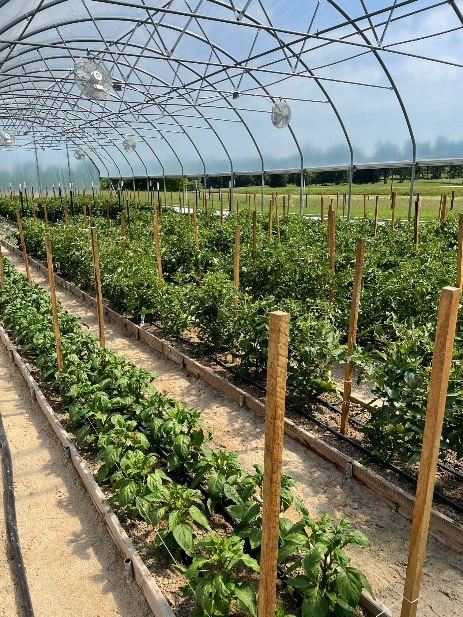
Crops off to a good start in the high tunnels at DSAC. Photos by B. Aly.
Bronwyn Aly (618-382-2662; baly@illinois.edu)
Fruit & Vegetable Production & Pest Management
Growing Sweet Corn At Higher Densities Doesn’t Increase Root Lodging Risk
URBANA, Ill. – Sweet corn growers and processors could be bringing in more profits by exploiting natural density tolerance traits in certain hybrids. That’s according to 2019 research from USDA Agricultural Research Service (ARS) and University of Illinois scientists.
But since root systems get smaller as plant density goes up, some in the industry are concerned about the risk of root lodging with greater sweet corn density. New research says those concerns are unjustified.
“Root lodging can certainly be a problem for sweet corn, but not because of plant density. What really matters is the specific hybrid and the environment, those major rainfall and wind events that set up conditions for root structural failure,” says Marty Williams, USDA-ARS ecologist, affiliate professor in the Department of Crop Sciences at Illinois, and author on a new study in Crop Science.
Williams and his co-authors used multiple approaches to understand the effects of planting density on root lodging in sweet corn. First, they planted sweet corn hybrid DMC 21-84 – a density-tolerant type that happens to be one of the most widely grown commercial hybrids – at five densities in experimental plots on U of I farms. When plants were at the tasseling stage, the researchers simulated a natural lodging event by flooding the field and knocking the corn over with a two-by-four.
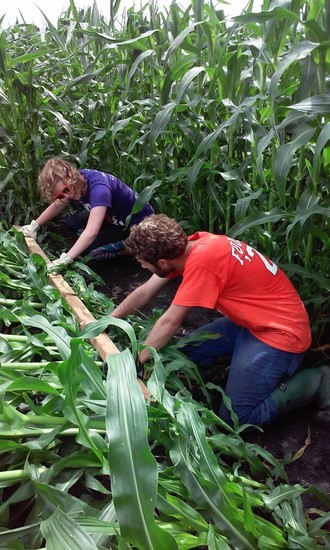
Undergraduate researchers simulate root lodging by knocking corn over with a two-by-four
“We mimicked a root lodging event with pure brute force,” Williams says.
When corn is flattened in the process of root lodging, it can, depending on the growth stage, right itself through the plant’s natural inclination to grow toward the light. As corn grows back upward from its repose, the base of the stem often carries a curved reminder of its lodging legacy, known as a gooseneck.
Williams and his team found most plants recovered to a near vertical position, albeit with a bit of goosenecking, within a few days of the artificial lodging event. They also measured yield metrics, and found no statistical difference in sweet corn yield between lodged and non-lodged plants.
But a two-by-four and brute force can’t replace nature.
“Testing a crop’s root lodging potential experimentally is inherently difficult. Simply put, a natural root lodging event may not happen in any given field experiment. As such, phenotyping crops for root lodging often employs the use of artificially created lodging events, like the ones we created,” Williams says. “While artificially created root lodging events are helpful, used alone they often fail to capture a broad range of environments in which the crop is grown.”
That’s why the research team leveraged data from on-farm sweet corn trials across Illinois, Minnesota, and Wisconsin. Between 2013 and 2017, the team evaluated economic optimum density for DMC 21-84 and 10 other hybrids under real-world farm management. And during that time, natural lodging events happened to occur in six of the 30 fields.
“We happened to take notes on lodging severity. It wasn’t our specific focus at the time, but we figured, let's go ahead and score this and maybe we'll use it later. Turns out it was great that we collected root lodging data, because we were able to use it for this study,” Williams says.
Those fortuitous notes showed that when sweet corn density increased from the current standard to the economic optimum density, typically a few thousand more plants per acre, there was absolutely no difference in the severity of lodging.
“What excited me about this work is that we combined an experiment where we created lodging artificially and looked at the response, and then we also tapped into this network of naturally occurring events. Together, they told a pretty convincing story,” Williams says. “Simply put, root lodging potential should not keep us from using plant density tolerant hybrids and growing them at their correct density. I mean, there’s always the possibility that root lodging could occur, but it's not going to be due to planting a few more plants.”
The article, “Economic optimum plant density of sweet corn does not increase root lodging incidence,” is published in Crop Science [DOI: 10.1002/csc2.20546]. Co-authors include Williams, Nicholas Hausman, Daljeet Dhaliwal, and Martin Bohn, Department of Crop Sciences, and Tony Grift, Department of Agricultural and Biological Engineering. Both departments are in the College of Agricultural, Consumer and Environmental Sciences at the University of Illinois. Williams’ primary affiliation is with the USDA-ARS Global Change and Photosynthesis Research Unit in Urbana, Illinois.
Source: Marty Williams, 217-244-5476, martin.williams@usda.gov
News writer: Lauren Quinn, 217-300-2435, ldquinn@illinois.edu
Date: May 10, 2021
April Brought a Mix of Winter, Spring, and Summer Weather
The statewide average April temperature was 52.6 degrees, right at the 1991–2020 normal and tied for the 48th warmest on record going back to 1895. The statewide average total April precipitation was 2.95 inches, 1.29 inches below the 1991–2020 normal and the 44th driest on record.
Temperatures varied considerably this past month. Average temperatures ranged between 5 and 20 degrees above normal in the first week to 10 days of the month, followed by a dramatic cool down. Average temperatures in the third week of April ranged from 5 to 20 degrees below normal.
April precipitation was highly variable from west to east. Month-long totals ranged from just over 6 inches in far western Illinois to less than an inch in northeast Illinois (Figure 1). These totals ranged from nearly 2 inches wetter than the 1981–2010 average April total precipitation to more than 2 inches drier than the average. Last month was the driest April on record at Chicago’s O’Hare Airport, with a total of 0.71 inches. Meanwhile, the stout 6.76 inches observed last month in Quincy was the sixth highest April precipitation total on record there.
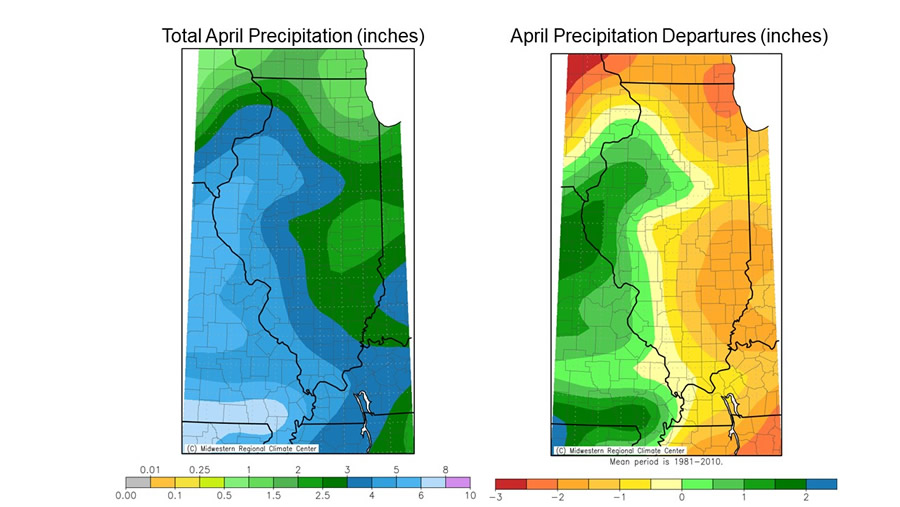
Figure 1. Maps show (left) total April precipitation and (right) April total precipitation departure from the 1991-2020 normal.
April snowfall is typical in northern Illinois, but quite unusual south of Interstate 64. The measurable snowfall on April 21 this year was the third latest on record in Champaign, the fourth latest on record in Peoria, and the latest on record in Belleville. The long-term station in Normal only has recorded observable snowfall after April 15 in 9 out of 117 years of record but has observed snowfall after April 15 in each of the past four years.
Looking ahead, the Climate Prediction Center outlooks are leaning heavily to warmer and wetter than normal conditions statewide for the last week of May. A warm-up would be much welcome following what has so far been a very cool start to the month of May.
Trent Ford, Illinois State Climatologist (217-244-1330; twford@illinois.edu)
10 Useful Rules for Fungicide Applications
This is the time of year when vegetable growers may start to apply fungicides. Below I list 10 rules that will help vegetable growers apply fungicides effectively and safely.
- Apply fungicides prior to the development of disease. Although many fungicides have systemic (“kick back”) action they will not completely eradicate diseases after they have started. And by the time a single disease lesion is observed in the field, many more lesions too small to observe are already working at your crop. Most systemic fungicides move less than an inch toward the tip of the plant or may just move from the upper to the lower side of the leaf.
- Use shorter spray intervals during weather conducive to plant disease. Each plant disease has its own “personality” and thus prefers different weather. However, most foliar plant diseases require leaf wetness. Therefore, during periods of rain and heavy dews, more frequent fungicide applications are a good idea. The normal range of spray applications is every 7 to 14 days. Cantaloupe and watermelon growers have the guesswork taken out of this process with a Purdue University program known as MELCAST. Ask the author for more details by calling (812) 886-0198 or go to melcast.info.
- Apply fungicides before a rain if possible. Water is necessary for most fungal spores to infect a plant and for the splash dispersal of many spores. Therefore, apply fungicides before a rain if it appears that the fungicide will have a chance to dry before the rain. It is not necessary to apply fungicides again after every rain. Most fungicides have a good sticker and will persist through rains pretty well. The MELCAST program takes into account the effect weather has on fungicides. More information can be found about rainfastness of fungicides in issue 685.
- Know when to alternate fungicides. Systemic fungicides, those with a single mode of action, if applied again and again in sequence, may cause disease causing fungi to mutate into a form resistant to the fungicide. It is always a good idea to alternate fungicide applications from one FRAC code (MOA code) number to another. Read the label carefully to find language about fungicide alternation. Contact fungicides with a FRAC code of M like chlorothalonil and mancozeb are very unlikely to cause such mutations and therefore may be applied in sequence. Although some fungicides may have designations such as M01 or M02, any fungicides with an M does not need to be alternated. Table 32 in the Midwest Vegetable Production Guide http://mwveguide.org/ will help growers alternate fungicides.
- Timing of fungicide applications is more important than nozzle type and spray pressure. Studies here in southern Indiana as well as by researchers in other areas of the country have found that nozzle type and spray pressure don’t make as much difference as we once thought. In general, the more water one uses per acre, up to about 50 gallons, results in better coverage.
- Some diseases cannot be managed by foliar sprays. Problems caused by soil borne fungi or nematodes cannot be controlled with foliar fungicides. Examples of these types of problems would be Fusarium wilt of watermelon or root-knot nematodes. Also, be certain that the problem you observe is really a disease. No amount of fungicide will improve a problem caused by soil fertility. Send a sample to a University Plant Diagnostic lab to find out the official diagnosis:
- Use copper products for bacterial diseases. For the most part, copper products are more effective against bacterial diseases than they are against fungal diseases. However, some bacterial diseases are caused by pathogens resistant to copper products.
- Some diseases require specialized fungicides. Diseases, such as downy mildew and Phytophthora blight, may require specialized fungicides. It may be wasteful to apply specialized fungicides all season long for diseases that are not a threat. For example, downy mildew of cucurbits usually does not arrive in Indiana until late in the season.
- Double-check the label for details. Rates may vary widely based on label changes and different formulations. While you are checking the rate, also make sure that the crop and disease are on the label. (Can this fungicide be applied in the greenhouse?) Did you get the rate from the Midwest Vegetable Production Guide for Commercial Growers? http://mwveguide.org/ Check the label anyway.
- Play it safe. Always adhere to the Post-Harvest Intervals, Re-Entry Intervals and Worker Protection Standards listed in the label. No one wants an accident or lawsuit. Besides, the label is the law.
- Strawberry variety
- Growing method: Matted row or plasticulture
- Location (state and county) where grown
- Approximate date of planting or year of matted row culture.
- Symptoms observed: Leaf spot, fruit rot, crown rot, or a combination of these.
University of Illinois Plant Clinic: https://web.extension.illinois.edu/plantclinic/
Purdue Plant and Pest Diagnostic Laboratory: http://www.ppdl.purdue.edu/ppdl/index.html.
This article was reprinted with permission from the Purdue Vegetable Crops Hotline https://vegcropshotline.org/
Dan Egel, Extension Plant Pathologist, Purdue Vegetable Crops Hotline, Purdue University (812-886-0198; egel@purdue.edu)
A New Strawberry Disease
A new strawberry disease has been found in Indiana and researchers are looking for samples from neighboring states to determine the extent of the problem. The disease, caused by a species of the fungus Neopestaltiopsis, has been reported in several southeastern states and other countries where it causes leafspots, fruit spots and a plant decline. In Indiana, the disease has been reported to cause a leafspot (Figure 1) and a plant decline.
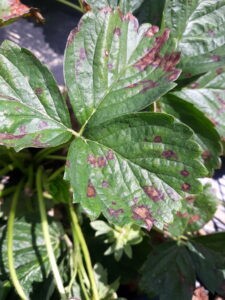
Figure 1. A leaf spot caused by Neopestaliopsis sp., a new strawberry disease to Indiana
Researchers are asking commercial growers who believe that they may have observed the disease to contact the Purdue University Plant and Pest Diagnostic Clinic http://www.ppdl.purdue.edu/ppdl/index.html.. The PPDL will waive sample handling fees for these samples until the researchers obtain the desired number of samples for the survey. Updates will be posted to the Hotline and to the PPDL website. Samples from multiple strawberry varieties and different types of production fields (matted row, plasticulture, high tunnel) are encouraged.
Information required for each sample:
This research will attempt to determine where the disease exists in Indiana and how the disease may be controlled. Results of these studies will be reported here when completed. The North American Strawberry Growers Association is sponsoring this research. For further questions contact Dan Egel at (812-886-0198; egel@purdue.edu).
Dan Egel, Extension Plant Pathologist, Purdue Vegetable Crops Hotline, Purdue University (812-886-0198; egel@purdue.edu)
Less Seriously
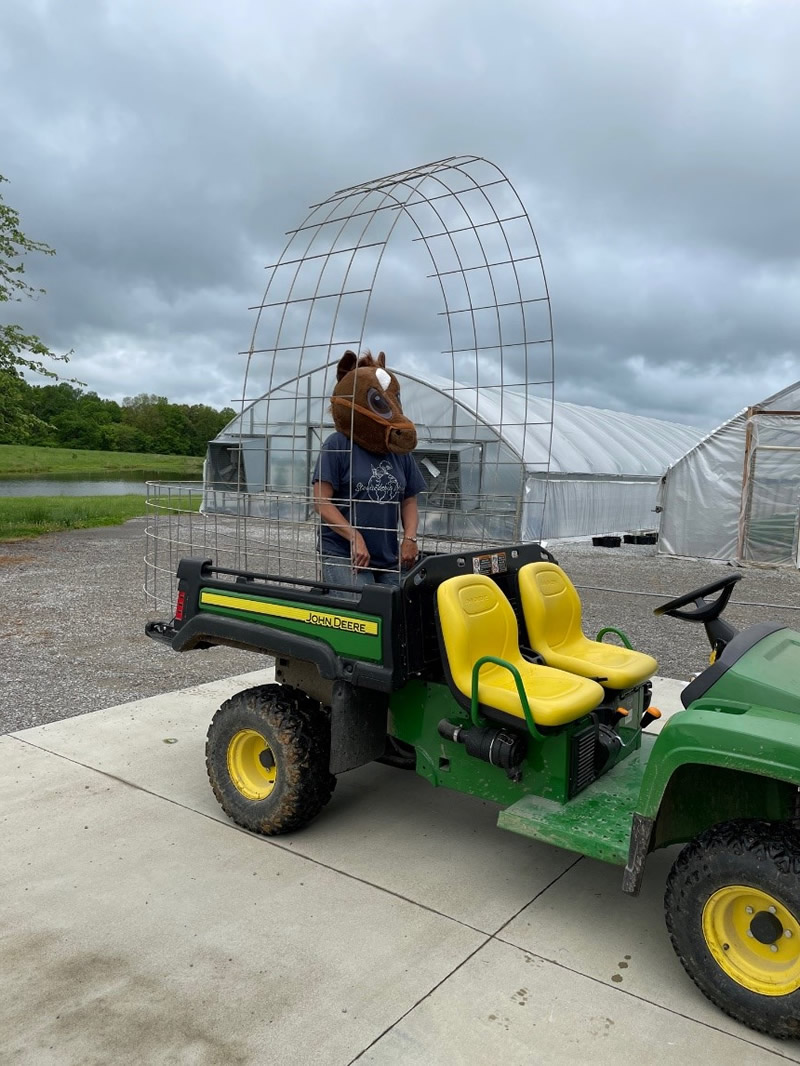
University of Illinois Extension Specialists in Fruit and Vegetable Production & Pest Management
Extension Educators – Local Food Systems and Small Farms |
||
Bronwyn Aly, Gallatin, Hamilton, Hardin, Pope, Saline, and White counties |
618-382-2662 |
|
Katie Bell, Franklin, Jackson, Perry, Randolph, & Williamson counties |
618-687-1727 |
|
Sarah Farley, Lake & McHenry counties |
847-223-8627 |
|
Nick Frillman, Woodford, Livingston, & McLean counties |
309-663-8306 |
|
Laurie George, Bond, Clinton, Jefferson, Marion, & Washington counties |
618-548-1446 |
|
Zachary Grant, Cook County | 708-679-6889 | |
Doug Gucker, DeWitt, Macon, and Piatt counties |
217-877-6042 |
|
Erin Harper, Champaign, Ford, Iroquois, and Vermillion counties |
217-333-7672 |
|
Grace Margherio, Jackie Joyner-Kersee Center, St. Clair County |
217-244-3547 |
|
Grant McCarty, Jo Daviess, Stephenson, and Winnebago counties |
815-235-4125 |
|
Katie Parker, Adams, Brown, Hancock, Pike and Schuyler counties |
217-223-8380 |
|
Kathryn Pereira, Cook County |
773-233-2900 |
|
James Theuri, Grundy, Kankakee, and Will counties |
815-933-8337 |
|
Extension Educators – Horticulture |
||
Chris Enroth, Henderson, Knox, McDonough, and Warren counties |
309-837-3939 |
|
Richard Hentschel, DuPage, Kane, and Kendall counties |
630-584-6166 |
|
Andrew Holsinger, Christian, Jersey, Macoupin, & Montgomery counties |
217-532-3941 |
|
Extension Educators - Commercial Agriculture |
||
Elizabeth Wahle, Fruit & Vegetable Production |
618-344-4230 |
|
Nathan Johanning, Madison, Monroe & St. Clair counties |
618-939-3434 |
|
Campus-based Extension Specialists |
||
Kacie Athey, Entomology |
217-244-9916 |
|
Mohammad Babadoost, Plant Pathology |
217-333-1523 |
|